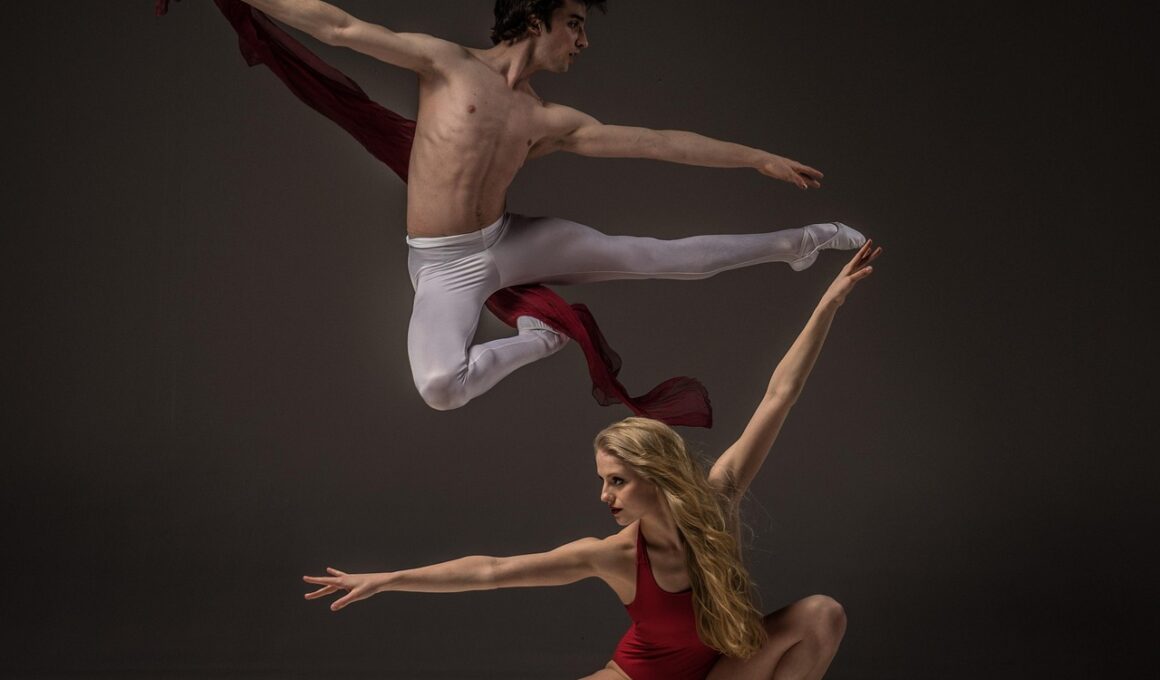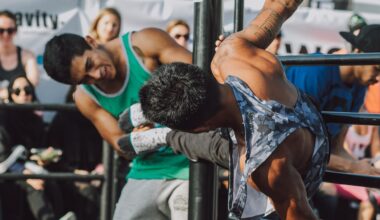How Age Affects Flexibility and What Athletes Can Do
Flexibility is an essential aspect of athletic performance, playing a vital role in enhancing movement capacity and reducing injury risk. As individuals age, physiological changes gradually diminish flexibility and overall mobility. The collagen fibers within our tendons and ligaments become stiffer over time, while muscle elasticity declines. This decrease in flexibility can impact an athlete’s performance, leading to tighter muscles and potentially causing imbalances. Consequently, older athletes may experience limitations in their range of motion, which affects their efficiency during various sports. Engaging in regular flexibility training can mitigate these effects significantly. For older athletes, stretching routines tailored to their specific needs are crucial to maintaining functional mobility. Incorporating dynamic stretches before workouts can activate muscles, while static stretching post-exercise promotes recovery and elongation of muscles. Utilizing techniques such as yoga or pilates aids in improving overall body strength while focusing on flexibility. Additionally, athletes can complement their flexibility training with strength exercises. Without proper attention to flexibility as age progresses, athletic performance can suffer. Therefore, establishing a routine that emphasizes flexibility can help athletes stay competitive as they age.
Understanding the Impact of Aging
Aging affects not just flexibility but also overall physical performance and coordination. Older individuals often notice that their muscles require longer recovery times after exertion, which can deter them from engaging in regular physical activity. As the body continues to age, changes in joint structure and muscle mass contribute to a decline in mobility. This scenario can lead to a vicious cycle of decreased activity, resulting in further reductions in flexibility and, consequently, muscle strength. Athletes, who are accustomed to the physical demands of their sport, may find themselves challenged as they age. Integrating flexibility and mobility exercises into their training regime can counteract many of aging’s negative impacts. Regular features like effective stretching routines can improve coordination and proprioception, allowing for better movement patterns. Strengthening core muscles also supports postural alignment, promoting an increased range of motion. In addition to physical strategies, motivated athletes should adopt a proactive mindset toward their changing bodies. Staying informed about the aging process can empower older athletes to adapt their training. This awareness can greatly enhance their ability to maintain effectiveness and minimize injuries.
One effective strategy to improve flexibility involves dynamic stretching, which includes movements like arm circles and leg swings. These warm-up techniques can enhance blood circulation, increase muscle temperature, and improve joint flexibility. Furthermore, these dynamic exercises prepare the body for the demands of various sports and activities. After engaging in these warming exercises, static stretching should follow to effectively lengthen the muscles and increase flexibility. Research indicates that static stretches performed post-exercise lead to significant improvements in flexibility over time. Regularly including routine activities, such as foam rolling, can also support mobility and flexibility objectives. Foam rolling releases tension in the fascia surrounding muscles, allowing for better movement patterns and reducing muscle soreness. Additionally, including activities like swimming or cycling into training can enhance joint mobility due to their low-impact nature. These opportunities can promote joint health while still providing cardiovascular benefits. Engaging in flexibility and mobility training as part of every session can yield exceptional results over time. It’s essential for athletes to dedicate time specifically to these exercises regularly. Following these recommendations can lead to improved muscle function, agility, and overall performance.
Aside from practical training techniques, it’s crucial to understand nutritional influences on flexibility. Consuming a balanced diet rich in essential nutrients can significantly aid overall muscle function and recovery. Nutrients such as omega-3 fatty acids, found in fish and flaxseeds, have anti-inflammatory properties that can enhance flexibility. Inadequate hydration also adversely impacts muscle elasticity and performance. Athletes should prioritize proper water intake throughout their training to maintain hydration levels. Furthermore, incorporating foods high in antioxidants, vitamins, and minerals helps safeguard muscle tissue from oxidative stress. These everyday foods can include fruits, vegetables, and whole grains, which collectively support optimal athletic performance. Moreover, specific supplements may enhance flexibility and mobility, such as collagen peptides. Supplemental collagen positively influences joint health, leading to increased mobility. Older athletes can assess their diet and make necessary adjustments to ensure they meet their flexibility goals. As flexibility plays a direct role in injury prevention, prioritizing nutrition and hydration should be integral aspects of an athlete’s training protocol. With adequate knowledge of nutrition, athletes can directly impact their flexibility over time.
The Role of Recovery in Flexibility
Recovery methods should also receive increased consideration from athletes focused on maintaining flexibility. Prioritizing quality rest and recovery periods is essential for muscle repair, especially as the body ages. Techniques such as active recovery days, where athletes engage in low-intensity movement, aid in accelerating recovery and decreasing stiffness. Moreover, incorporating regular massage therapy can significantly enhance flexibility by promoting blood flow to the muscles, leading to deeper relaxation. The therapist can target specific tight areas to maintain optimal mobility. Another effective recommendation involves varying training intensities and incorporating rest days into weekly routines. This approach permits muscle adaptation, improving flexibility progressively. Additionally, the inclusion of restorative activities like yoga or tai chi can effectively combat stiffness while promoting relaxation and mindful movement patterns. To maximize recovery, athletes must adapt their training schedules to reflect their needs, particularly as changes occur with age. Practicing mindfulness and stress reduction techniques can also positively influence flexibility. Athlete education plays a significant role in understanding recovery strategies, not just for performance but also for long-term health, ensuring that every aspect of training contributes positively.
The Benefits of Flexibility for Older Athletes
Maintaining flexibility offers various health benefits beyond athletic performance for older adults. These include improved balance and coordination, which help reduce the risk of falls, a common concern among the aging population. Increased flexibility allows for more fluid movements in daily activities, promoting independence and an enhanced quality of life. Older athletes should also be mindful that regular flexibility training fosters mental discipline, encouraging commitment to a healthy lifestyle. Furthermore, focusing on flexibility can enhance overall body awareness and contribute to better motor control. With improved flexibility, athletes often experience decreased feelings of stiffness and discomfort in their muscles, allowing them to enjoy movements without limitations. Engaging in group classes focused on flexibility, such as yoga or Pilates, can also provide socialized benefits, aiding mental well-being and emotional support among peers. In this regard, flexibility training not only serves the physical aspects but contributes to psychological health. Athletes can explore customized flexibility training plans to align with their specific sports. Leveraging these advantages will keep older athletes active and competitive well into older age, benefiting their overall well-being.
In conclusion, as age advances, the inevitable decline in flexibility and mobility requires proactive approaches from athletes. Specific training programs tailored to meet the physical demands of sports while considering age-related changes can significantly influence outcomes. Establishing a balanced routine inclusive of dynamic and static stretching is imperative for optimal flexibility benefits. Nutritional elements must also be prioritized, aiming to create a supportive environment for muscles. Thus, maintaining flexibility takes patience and diligent practice, but the long-term benefits are invaluable. Recovery strategies, varying training intensity, and the integration of relaxation techniques all contribute to enhanced flexibility outcomes. As they adapt their training, older athletes will not only uphold their competitive edge but ensure body functionality for daily living. Athletes can enjoy sports longer and improve their overall life satisfaction through consistent flexibility work. Embracing a holistic approach that incorporates nutrition, recovery, and stretching is critical for longevity in sports. By understanding the impact of aging on their performance, older athletes can adapt and thrive. Ultimately, flexibility should never be neglected, serving as a foundation for a healthy, active lifestyle.
Regular monitoring and adapting of flexibility training can help older athletes maintain their competitiveness. Collaboration with trained professionals within the fields of sports and nutrition can optimize results. There are many resources available to assist individuals in crafting a personalized approach to flexibility and mobility. As these athletes keep learning about their bodies and how flexibility affects their overall function, they will be equipped with the necessary tools to thrive in their respective sports. Older athletes can achieve remarkable progress even as aging changes their physical state by cultivating flexibility into their routine. Tracking progress through journals or assessments can accelerate learning and adaptation. By fostering environments supportive of flexibility, older athletes can inspire others while pursuing their athletic goals, showcasing what active aging can achieve. With appropriate dedication to flexibility, the pathways to avoid injury and sustain a high quality of life become clearer. Emphasizing these aspects can lead to improved performance, prolonged engagement in athletics, and a stronger sense of community among athletes. In this way, age does not limit athletic potential but can enhance the wisdom and experience brought to performance.


